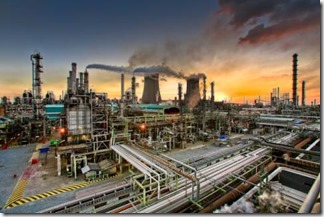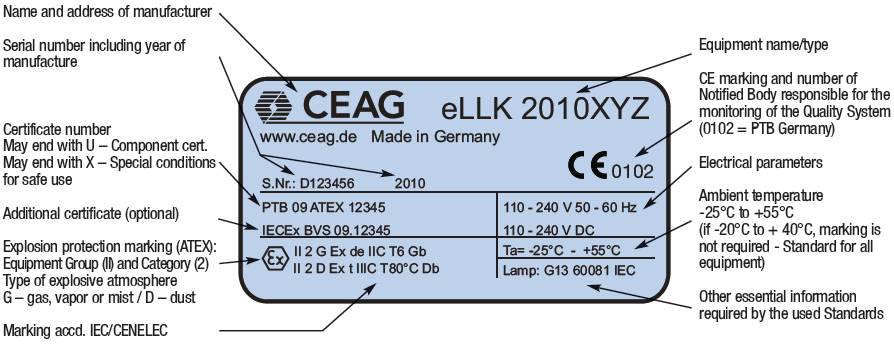Hazardous Areas – IEC and NEC/CEC Comparison
 Sasol, South Africa
Sasol, South Africa Depending on where in the world you work, you are likely following one of two standards
- International Electrotechnical Commission (IEC)
- National Electrical Code/Canadian Electrical Code (NEC/CEC)
The different nature of the two systems makes a direct comparison almost impossible.
If you do need to work with both systems or transition from one to the other, hopefully, the following will make this easier.
Since July 2003, Ex products in Europe must also be certified to the ATEX directive (ATEX 94/9/EC).
Zones & Divisions
| IEC Classification IEC 60079 |
|
ANSI/NFPA 70 NEC Article 500 |
| Gas and Vapours |
| Zone 0 |
flammable atmosphere highly likely to be present - may be present for long periods or even continuously |
| Zone 1 |
flammable atmosphere possible but unlikely to be present for long periods |
| Zone 2 |
flammable atmosphere unlikely to be present except for short periods of time - typically as a result of a process fault condition |
| Dusts |
| Zone 20 |
dust cloud likely to be present continuously or for long periods |
| Zone 21 |
dust cloud likely to be present occasionally in normal operation |
| Zone 22 |
dust cloud unlikely to occur in normal operation, but if it does, will only exist for a short period |
|
|
| Class (nature of the material) |
| Class I |
hazardous because flammable gases or vapors are present in the air in quantities sufficient to produce explosive or ignitable mixtures |
| Class II |
hazardous because combustible or conductive dusts are present |
| Class III |
hazardous because ignitable fibers or flying's are present, but not likely to be in suspension in sufficient quantities to produce ignitable mixtures. |
| Division (probability of material being present) |
| Division 1 |
the substance referred to by class is present during normal conditions |
| Division 2 |
the substance referred to by class is present only in abnormal conditions, such as a container failure or system breakdown |
|
Temperature & Explosion Groups
| Explosion Groups |
|
Temperature Class |
| |
IEC |
NEC/CEC |
| Inflammable material |
Zone |
Group |
Class |
Division |
Group |
| Gas and Vapours |
| Acetylene |
0,1 or 2 |
II C |
I |
1 or 2 |
A |
| Hydrogen |
0,1 or 2 |
II B+H2 |
I |
1 or 2 |
B |
Propylene oxide
Ethyl oxide
Butadiene |
0,1 or 2 |
II B |
I |
1 or 2 |
B |
Cyclopropane
Ethly ether
Ethylene |
0,1 or 2 |
II B |
I |
1 or 2 |
C |
Acetone
Benzene
Butane
Hexane
Paint solvents
Natural gas |
0,1 or 2 |
II A |
I |
1 or 2 |
D |
| Dusts |
| Metal dust |
|
III C |
II |
|
E |
| Coal dust |
|
III C |
II |
|
F |
| Grain dust |
|
III B |
II |
|
G |
Wood
Paper
Cotton |
|
III A |
III |
|
|
|
|
Temperature
oC |
IEC |
NEC/CEC |
| 85 |
T6 |
T6 |
| 100 |
T5 |
T5 |
120
135 |
T4
T4 |
T4A
T4 |
160
165
180
200 |
T3
T3
T3
T3 |
T3C
T3B
T3A
T3 |
215
230
260
280
300 |
T2
T2
T2
T2
T2 |
T2D
T2C
T2B
T2A
T2 |
| 450 |
T1 |
T1 |
|
| Gas Group / Temperature Class |
| Group |
T1 |
T2 |
T3 |
T4 |
T5 |
T6 |
| I |
Methane |
|
|
|
|
|
| IIA |
Acetone
Methane
Ethane
Benzene
Methanol
Toluene
Propane
Acetic Acid
Ammonia
|
Ethanol
Cyclohexane
Propanol 2
N-Butyl alcohol
N-butane |
Diesel fuel
Aircraft fuel
Fuel oil
N-Hexane
Heptane
Kerosene |
Acetaldehyde
|
|
|
| IIB |
Coal Gas |
Ethylene
Ethylene oxide
Propanol 1
Methyl Ethyl
Ketone |
Ethylene glycol
Hydrogen Sulphide
Tetrahydrofuran |
Ethyl Methyl Ether
|
|
|
| IIC |
Hydrogen |
Acetylene |
|
|
|
|
|
|
| Ignition Temperatures for Common Flammable Dusts and Fibers |
| |
Ignition Temperature |
| Material |
Cloud |
Layer |
| Coal Dust |
380°C |
225°C |
| Polythene |
420°C |
(melts) |
| Methyl Cellulose |
420°C |
320°C |
| Starch |
460°C |
435°C |
| Flour |
490°C |
340°C |
| Sugar |
490°C |
460°C |
| Grain Dust |
510°C |
300°C |
| Phenolic Resin |
530°C |
> 450°C |
| Aluminium |
590°C |
> 450°C |
| PVC |
700°C |
> 450°C |
| Soot |
810°C |
570°C |
|
Equipment & Protection Levels
IEC/ATEX Equipment Protection
Level (EPL) |
|
IEC Equipment Classification |
| IEC 60079 |
|
94/9/EC (ATEX) |
EPL |
Zone(s) |
Group |
Category |
Protection
Level |
| Gas/Vapours |
| Ga |
0,1,2 |
II |
1 G |
very high |
| Gb |
1,2 |
II |
2 G |
high |
| Gc |
2 |
II |
3 G |
increased |
| Dusts |
| Da |
20,21,22 |
III |
1 D |
very high |
| Db |
21,22 |
III |
2 D |
high |
| Dc |
22 |
III |
3 D |
increased |
| Methane, Coal Dust |
| Ma |
Mining |
I |
M1 |
very high |
| Mb |
Mining |
I |
M2 |
high |
NEC/CEC Equipment Classification
| Method of Protection |
Division |
| Intrinsic Safety, IS |
1 or 2 |
| Explosion-Proof, XP |
1 or 2 |
| Pressurization, X,Y,Z |
1 or 2 |
| Non-incendive equipment |
2 |
|
Specifically assessed equipment
|
2 |
|
|
| Code |
Description |
EPL |
Type of Protection |
| Ex e |
Increased safety |
Gc |
Intended to prevent a potential ignition arising |
| Ex n |
Type - n protection |
Gc |
| Ex ia |
Intrinsic safety 'ia' |
Ga |
Intended to limit the ignition energy of the equipment |
| Ex ib |
Intrinsic safety 'ib' |
Gb |
| Ex ic |
Intrinsic Safety 'ic' |
Gc |
| Ex n |
Type - n protection |
Gc |
| Ex p |
Purge/pressurized protection |
Gb |
Intended to prevent the explosive atmosphere contacting the ignition
source |
| Ex px |
Purge/pressurized protection 'px' |
Gb |
| Ex py |
Purge/pressurized protection 'py' |
Gb |
| Ex pz |
Purge/pressurized protection 'pz' |
Gc |
| Ex m |
Encapsulation |
Gb |
| Ex ma |
Encapsulation |
Ga |
| Ex mb |
Encapsulation |
Gb |
| Ex o |
Oil immersion |
Gb |
| Ex n |
Type - n protection |
Gc |
| Ex d |
Flameproof protection |
Gb |
Intended to prevent an ignition from escaping outside the equipment |
| Ex q |
Sand / powder (quartz) filling |
Gb |
| Ex nC |
Type - n protection |
Gc |
| Ex s |
Special protection Refer to equipment marking and documentation |
|
Degrees of Protection
Ingress Protection Codes
IPxx (IEC 60079) |
|
NEMA Enclosure Types (& IEC IP Equivalent) |
| x |
1st Numeral
Solid Bodies |
2nd Numeral
Liquids |
3rd (optional)
Impact |
| 0 |
No protection |
No protection |
No protection |
| 1 |
Objects > 50 mm dia. |
Vertically dripping water |
0.225 Joule |
| 2 |
Objects > 12.5 mm dia. |
Angled dripping water (up to 15o) |
0.375 Joule |
| 3 |
Objects > 2.5 mm dia. |
Spraying water (up to 60o) |
0.5 Joule |
| 4 |
Objects > 1.0 mm dia. |
Splashing water (all directions) |
2.0 Joule |
| 5 |
Dust protected |
Low pressure water jets |
6.0 Joule |
| 6 |
Dust tight |
High pressure water jets |
20.0 Joule |
| 7 |
|
Temporary immersion |
|
| 8 |
|
Continuous immersion |
|
|
|
| Type |
Area |
Description |
IP |
| 1 |
Indoor |
General Purpose |
10 |
| 2 |
Indoor |
Drip proof protection against falling water and dirt |
11 |
| 3 |
Indoor
Outdoor |
Dust & rain tight protection against windblown dust, rain, and sleet & damage from formation of ice |
54 |
| 3R |
Outdoor |
Rain proof & ice/sleet proof protection against falling rain & damage from formation of ice |
14 |
| 3S |
Outdoor |
Dust tight, rain tight, & ice/sleet proof protection against sleet and damage from formation of ice |
55 |
| 4 |
Indoor
Outdoor |
Water tight & dust tight |
66 |
| 4X |
Indoor
Outdoor |
Water tight, dust tight, & corrosion resistant protection from corrosion, hose directed water and damage from formation of ice |
66 |
| 5 |
Indoor |
Dust tight & drip tight protection against dust, fibres, falling dirt, and dripping non-corrosive liquids |
52 |
| 6 |
Indoor
Outdoor |
Temporary submersion protection against falling dirt, dust, fibres, hose directed water and temporary submersion in water |
67 |
| 6P |
Indoor
Outdoor |
Prolonged submersion protection against falling dirt, dust, fibres, hose directed water and prolonged submersion in water |
67 |
| 7 |
Indoor |
Class I, Division 1, Groups A, B, C, and D hazardous locations, air-break equipment |
|
| 8 |
Indoor
Outdoor |
Class I, Division 1 Groups A, B, C, and D hazardous locations, oil-immersed equipment |
|
| 9 |
Indoor |
Class II, Division 1, Groups E, F, and G hazardous locations, air-break equipment |
|
| 10 |
Mining |
Mining applications |
|
| 12 |
Indoor |
Dust tight & drip tight protection against dust, fibres, falling dirt, and dripping non-corrosive liquids (enclosure without knockouts) |
52 |
| 12K |
Indoor |
Dust tight & drip tight protection against dust, fibres, falling dirt, and dripping non-corrosive liquids (enclosure with knockouts) |
52 |
| 13 |
Indoor |
Dust tight & oil tight protection against dust, spraying of water, oil, and noncorrosive coolant. |
54 |
|
Product Markings
Typical IEC Type Marking

Typical NEC/CEC Type Marking
As a general rule equipment should be marked as follows:
- Company/Manufacturers name
- Class I, II and/or III
- Division 1 and/or 2
- Group A, B, C, D, E, F and/or G
- Approving NRTL (Nationally Recognized Testing Laboratory) logo
- Product identification
- Serial number
- Other relevant safety information
- Enclosure Type Rating
Finally
Finally the end... When I started this post I thought it would be one of the easier ones - reproduce and sort a few tables and I'm done. Well, it took a lot longer than I had anticipated and quite a bit more work. Anyhow now that it's finished I relieved. Having said that, if anyone notices any errors or has suggestions to improve the post, please add them below and I'll update the post as necessary.